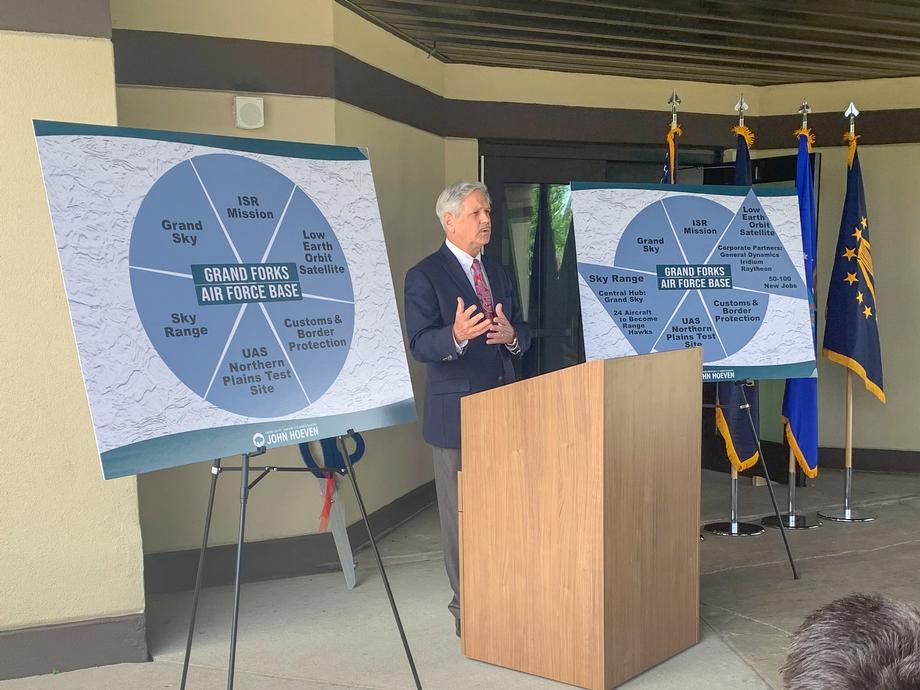Hoeven: Partnerships at GFAFB & Grand Sky Have Transformed This Region's Role in Defending the Nation
Senator Outlines Significance of New Space Networking Center, LEO Satellite Mission & Hypersonic Missile Testing
GRAND FORKS, N.D. – Senator John Hoeven today outlined how new partnerships at the Grand Forks Air Force Base (GFAFB) and Grand Sky have transformed the role the region plays in the nation’s defense. In particular, Hoeven highlighted:
- The nearly $325 million contract between the Space Development Agency (SDA) and a team led by General Dynamics Missions Systems, Iridium and Raytheon to develop the Space Networking Center at GFAFB, as well as a similar facility at Redstone Arsenal in Alabama.
- The center will support SDA’s low-Earth orbit (LEO) satellite mission and will serve as the backbone for U.S. military communications across the globe.
- Hoeven was joined today by SDA Director Derek Tournear, as well as representatives from General Dynamics and Iridium, to discuss the project and dedicate the facility where the center will be housed.
- The Sky Range program at Grand Sky, under which the Test Resource Management Center (TRMC) will convert 24 Global Hawk aircraft to be used for hypersonic missile testing.
Hoeven stressed how these two projects build upon the convergence he has worked to establish between federal, state, military, private and academic partners in the region, strengthening both national defense and the local economy. In addition to Sky Range and the LEO mission, these include the tenants of Grand Sky; the intelligence, surveillance and reconnaissance (ISR) mission and Customs and Border Protection (CBP) unmanned aerial systems (UAS) operations at GFAFB; and the Northern Plains UAS Test Site.
“The SDA’s Space Networking Center, which will be developed by General Dynamics, Iridium, Raytheon and other partners, will place North Dakota at the center of U.S. space operations,” said Hoeven. “Further, the LEO satellite mission and the Sky Range hypersonic missile testing program are two more strong examples of the partnerships we’ve established to secure Grand Forks’ role in the future of our nation’s defense. These new operations greatly complement GFAFB’s leadership in the Air Force’s ISR efforts, as well as the dynamic, world-class UAS industry we’ve built in the Red River Valley.”
Standing up SDA’s LEO Mission
Last year, Senator Hoeven announced Air Force approval to stand-up SDA’s new LEO satellite mission at Grand Forks, following his efforts with the SDA, including Director Tournear, and Senator Kevin Cramer. Over time, the mission could include not only operating SDA satellites but linking them with UAS, which would complement the base’s role in the Air Force’s ISR missions.
Prior to this, Hoeven hosted SDA Director Tournear in North Dakota to outline efforts to establish the new center and announce the new laser communications project, which SDA is pursuing in conjunction with General Atomics. The senator also joined Tournear to review launch operations at Cape Canaveral, where the SDA launched five satellites central to the space networking center and the General Atomics project.
Bringing Sky Range to North Dakota
Last week, Hoeven announced that the Air Force will transfer all twenty Global Hawk Block 30 aircraft to Grand Sky to be converted into Range Hawks for the TRMC Sky Range hypersonic missile testing program, in addition the four Block 20 aircraft that were transferred to Grand Sky last year. This was possible due to an agreement that Hoeven secured with Air Force Chief of Staff Gen. Charles Brown, which also ensured the Air Force makes additional investments in Grand Forks to support future missions.
As a member of the Senate Defense Appropriations Committee, Hoeven:
- Secured language supporting the Sky Range program and pressing the Air Force to make the Block 30 fleet available to Sky Range.
- Hosted TRMC Director George Rumford in North Dakota last year to see firsthand the opportunities that Grand Sky offers the agency and the Sky Range program.
- Helped secure a contract for Northrop Grumman to convert four Global Hawk Block 20s at Grand Sky into Range Hawks for use under the Sky Range program.
Currently, the Department of Defense (DoD) uses an aging fleet of ships deployed across a Pacific Ocean corridor to test hypersonic missiles. DoD is only able to conduct four to six tests per year, as it takes several weeks to deploy and position the ships for each test. Additionally, this process signals the testing schedule to our adversaries. Sky Range would replace the ships, which are expensive to operate, with modified Global Hawks that could deploy quickly and increase testing capacity through the creation of additional testing corridors in the Pacific and elsewhere.

-###-
Next Article Previous Article
